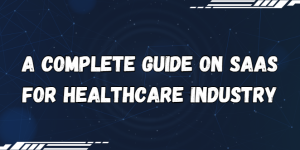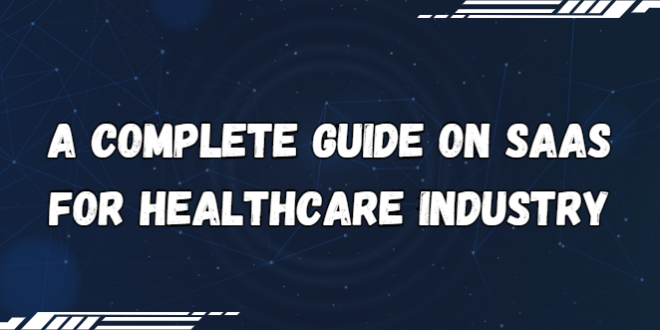SaaS, or Software as a Service, is a cloud-based software delivery model that has gained significant popularity in various industries, including healthcare. It allows healthcare organizations to access and use software applications over the internet, eliminating the need for complex installations and infrastructure maintenance.

2. Benefits of SaaS in Healthcare
SaaS offers numerous benefits to the healthcare industry. It enables cost savings by eliminating the need for on-premises infrastructure and reducing upfront software licensing fees. Additionally, it provides scalability, flexibility, and easy access to software updates and upgrades.
3. Enhanced Collaboration and Communication
SaaS solutions in healthcare facilitate improved collaboration and communication among healthcare professionals. It allows for secure data sharing and real-time access to patient information, enabling more efficient and coordinated care delivery.
4. Streamlined Operations and Workflow
Implementing SaaS in healthcare streamlines operations and workflow processes. It automates tasks such as appointment scheduling, billing, and documentation, reducing administrative burdens and improving overall efficiency.
5. Improved Data Security and Compliance
Data security is a critical concern in healthcare. SaaS providers prioritize data protection measures, including encryption, access controls, and regular backups. They also ensure compliance with industry regulations, such as HIPAA, to safeguard patient privacy.
6. Customization and Integration Capabilities
SaaS solutions for healthcare offer customization and integration capabilities. Healthcare organizations can tailor the software to their specific needs and integrate it with existing systems, such as electronic health records (EHR) or billing systems.
7. Telehealth and Remote Patient Monitoring
SaaS plays a crucial role in enabling telehealth and remote patient monitoring services. It provides the necessary infrastructure and tools for virtual consultations, remote monitoring of vital signs, and secure communication between healthcare providers and patients.
8. Analytics and Data Insights
SaaS platforms often include advanced analytics and reporting features. Healthcare organizations can leverage these capabilities to gain valuable insights from patient data, identify trends, and make data-driven decisions to improve patient outcomes.
9. Considerations for Choosing a SaaS Provider
When selecting a SaaS provider for healthcare, it’s essential to consider factors such as data security measures, compliance certifications, customer support, scalability, and pricing models. Evaluating these aspects ensures that the chosen provider meets the specific needs of the healthcare organization.
10. Integration with Electronic Health Records
Integration between SaaS solutions and electronic health records (EHR) is crucial for seamless data exchange and continuity of care. Healthcare organizations should assess the compatibility and interoperability of the SaaS software with their existing EHR system.
11. Training and User Adoption
Successful implementation of SaaS in healthcare requires proper training and user adoption. It is important to provide comprehensive training to healthcare staff and ensure that they are comfortable using the SaaS software in their daily workflows.
12. Compliance with Regulatory Requirements
Healthcare organizations must ensure that the chosen SaaS provider complies with relevant regulatory requirements, such as HIPAA. They should assess the provider’s security measures, data privacy policies, and any necessary certifications or audits.
13. Data Backup and Disaster Recovery
Data backup and disaster recovery strategies are critical considerations when using SaaS in healthcare. It is essential to understand the provider’s backup procedures, data redundancy measures, and disaster recovery plans to mitigate the risk of data loss.
14. Evaluating Return on Investment (ROI)
Assessing the return on investment is essential before implementing a SaaS solution in healthcare. It involves evaluating the cost savings, efficiency improvements, and potential revenue generation resulting from the adoption of the software.
15. Continuous Monitoring and Support
After implementing a SaaS solution, continuous monitoring and support are necessary to ensure smooth operation and address any issues that may arise. Healthcare organizations should establish a support system and maintain regular communication with the SaaS provider.
16. Keeping Up with Technology Advancements
Technology advancements in healthcare are continually evolving. It is crucial for healthcare organizations to stay updated with the latest trends and innovations in SaaS and leverage new features and functionalities to enhance patient care and operational efficiency.
17. Case Studies and Success Stories
Exploring case studies and success stories of other healthcare organizations that have implemented SaaS can provide valuable insights and inspiration. It allows for learning from real-world examples and understanding best practices for successful implementation.
18. Evaluating Future Needs and Scalability
When choosing a SaaS solution for healthcare, it is important to consider future needs and scalability. The software should have the capability to adapt and grow with the organization’s evolving requirements, ensuring long-term value and sustainability.
19. Selecting the Right SaaS Solution
Selecting the right SaaS solution for the healthcare industry requires careful evaluation and consideration of various factors. It is advisable to involve key stakeholders, conduct thorough research, and even seek expert consultation to make an informed decision.
20. Conclusion
In conclusion, SaaS offers significant benefits to the healthcare industry, including cost savings, streamlined operations, improved collaboration, and enhanced data security. When implementing SaaS, healthcare organizations should consider factors such as customization, integration, training, compliance, and scalability. By carefully selecting the right SaaS solution and staying abreast of technological advancements, healthcare providers can optimize their operations and deliver high-quality care. Until we meet again in another exciting article, happy SaaS implementation!
 Spacetimes A collection of the latest news and information from various trusted sources
Spacetimes A collection of the latest news and information from various trusted sources
